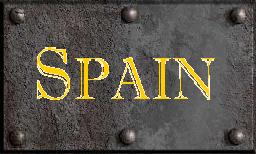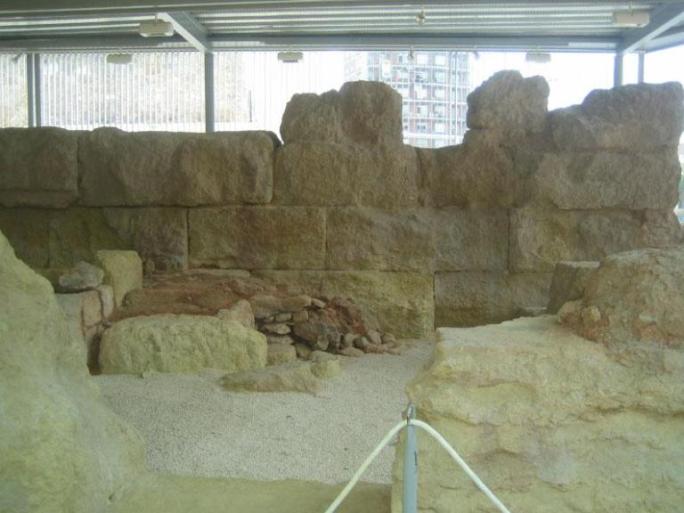



Was it called "Spain" in ancient times?
At the start of the Punic Wars (264 BC) the area we now know as Spain was not a single state. It was divided into a number of regions, the largest being Lusitania in the west, Andalusia in the south and Celtiberia to the north and east.
Each of these regions was again divided between numerous tribes, each with their own king or chieftain.
The entire peninsula, however, was known to the Romans as "Hispainia" in Latin, "Ispania" in the Greek.
The region was also known as "Iberia" to the Greeks, possibly derived from the Ebro river in the northeast of the peninsula.
These terms have been universally translated as "Spain" in the English translation of Livy's War With Hannibal and Polybius' The Rise of the Roman Empire (Polybius lived from 200 BC to 118BC, Livy from 59 BC to 17 AD). This convention has been followed in the House of Thunder series.
Gades:
Modern day Cadiz. Gades was originally founded as a Phonecian trading city as early as 1100 BC - at the end of the Bronze Age. It is possibly the oldest continuously inhabited city in Europe.
Gades was Hamilcar's initial base of operations when he first arrived from carthage with his army.
The ancient city was built on the isthmus of land forming the outer rim of the harbour, which can still be seen on Google Maps:
New Carthage:
After Hamilcar Barca was killed his son-in-law, Hasdrubal, was elected by the Carthaginian army in the field as their leader. Hasdrubal continued Hamilcar's program: establishing a Carthaginian stronghold in Spain.
While still using the power of the Carthaginian army when required, Hasdrubal placed an increased emphasis on diplomacy to expand and consolidate Carthaginian control.
Hasdrubal founded New Carthage in 227/8 BC as the Carthaginian capital of Spain. The site was selected as it had a supurb natural harbour and was close to the all important Spanish silver mines.
The city remained a symbol of Carthaginian power and became Hannibal Barca's base after Hasdrubal's assasination. It finally fell to a Roman force commanded by Scipio the younger in 209 BC.
The Romans controlled "Carthago Nova" until it was destroyed by the Vandals in 435 AD during the collapse of the Roman Empire. It was rebuilt, however, and is still inhabited - known today as Cartegena. Part of the great defensive wall constructed by Hasdrubal survives and can be seen in a museum built over the site, as described in the Costa Colida Chronicle on this link.
All that remains of Hasdrubal's capital:

New Cathage:
Saguntum:
In the 8th century BC Greek colonies began to spread into the central and western Mediterranean. Syracuse was established on the coast of Sicily in 734 BC as a colony of Corinth, Tarentum on the southern coast of Italy in 706 BC as a colony of Sparta.
The Greeks continued to push westwards, establishing Massilia (modern day Marseille) in 600 BC and moving on to establish a colony at Emporion, north of the Ebro in Spain, in 575 BC (Emporion has become the modern day village of Empuries, near L'Escala on the Gulf of Roses). They were setting up a maritime trading empire to rival the long established Phoenician empire of which Carthage had become the centre.
The Greek colonists continued to make their way down the east coast of Spain, arriving at the Iberian town of Arse. The Greeks settled here as well and the city of Saguntum grew on a rocky outcrop overlooking the coastal plain and the Palencia River.
The settlements of Massilia and Emporion grew to be dominated by the Greek colonists; they became Greek cities which dominated their hinterlands. In Saguntum, however, the Greeks were not so succesful in dominating the hardy native Iberians. Saguntum grew as a Greek/Spanish city, divided in its ethnicity and, it turned out, its loyalties.
When Rome began her program of aggressive expansion, her gaze fell on the Greek cities of Magna Gracia - on the southern coast of the Italian Peninsula. The Greeks, led by King Pyrrhus, sent an army to help their colonies fight off the Roman attack. They failed.
After their defeat in the Pyrrhic wars the Greeks recognised Rome as a powerful ally against their older traditional enemies: Illyria and Macedonia. Greece became a submissive ally, a client state of Rome. Many of the Greek colonies in the Mediterranean followed their motherland into alliance with and subservience to Rome. Massilia and Emporion, for example, became Roman military bases. Syracuse, under the rule of King Heiro, initially fought against the Roman invasion of Sicily but swiftly reached an accomodation and remained allied with Rome until Heiro's death.
Saguntum, however, remained divided between the pro-Roman Greeks and the native Iberians. It must have come as a bitter blow to the pro-Roman Greek faction in the city when Rome handed them over to Carthaginian control. They did this in the treaty of 226 BC which the Romans offered Hasdrubal in order to secure their western flank while they dealt with the Gauls and the Illyrians. This treaty acknowledged Carthaginian control of all Spain (the Iberian Peninsula) south of the River Ebro - including Saguntum.
If shocked, the pro-Roman Saguntines were not vanquished. Rome, by her high-handed seizure of Corsica and Sardinia, had demonstrated that she regarded the end of the Fisrt Punic War as an interlude rather than a conclusion.
By 219 BC Rome had dealt with the Gauls in the Po Valley, the north of Italy. They had dealt them crushing blows at Telamon in 225 BC, Clastidium, Acerrae and Mediolanum in 222 BC. They had also dealt with Queen Teuta and her Illyrians to their east. They had vanquished Queen Teuta and her treacherous successor, Demetrius. Roman eyes once again turned west, to the growing power of Carthage in Spain.
This renewed interest found expression inside Saguntum as a resurgence of the pro-Roman faction in the Senate of teh city.
A crossroads was reached and a vote taken, but the pro-Romans failed to carry the day. They defined this defeat as a "deadlock" and a political crisis and sent to Rome seeking help. The help arrived in the form of an armed delegation of soldiers who promptly assasinated the pro-Carthaginian faction of the Saguntine Senate. Another vote was taken and hadly surprisngly, the pro-Roman faction prevailed this time. Saguntum joined the Roman camp and began attacking native Iberian tribes allied to Hannibal and the Carthaginians.
(It should be noted that what we know of Rome's actions in Saguntum comes from a pro-Roman account - see Polybius III 15 - in all likelyhood the death toll amongst pro-Carthaginian Saguntines was much higher.)
The Romans must have been perfectly aware of the position these Saguntine attacks placed Hannibal in.
He had become leader of the Carthaginian forces in Spain just two years earlier following the assasination of his brother-in-law, Hasdrubal. Hannibal's control over Spain relied on the system of alliances and treaties Hasdrubal had negotiated with the Spanish tribes. If Hannibal did not respond to these Saguntine attacks on his allies, then the whole basis of Carthaginian power in Spain was threatened.
It was a genuine "win-win" situation from the Roman perspective; if Hannibal did not attack Saguntum, Carthaginian power in Spain was finished and the territory was wide open for Rome to exploit. If he did attack Saguntum, it would provide a "casus belli," a pretext for going to war, for crushing this growing power before it could mature and achieving the same result for Rome in the end. Win win.
Saguntum was the Roman Gleiwitz incident. In fact, several days before that incident and the subsequent invasion of Poland, Hitler has been quoted as telling his Generals that he would provide a "casus belli".
"Its credibility doesn't matter," Hitler said, "the victor will not be asked whether he told the truth."
Similar sentiments may well have been whispered in the Roman Senate.
Saguntum (modern day Sagunt):
The Ebro:
As the largest river in Spain, the Ebro is a formidable barrier. It is wide, deep and, at 928km in length, runs almost right across the Iberian Peninsula.
It was a perfect and obvious dividing line between Roman and Carthaginian spheres of influence as recognised in the treaty of 226 BC.
It is easy to imagine Hannibal feeling that he was taking an irrevocable step in crossing the Ebro, just as Caesar was to later feel as he crossed the Rubicon.
In reality, however, it is unlikely that Hannibal experienced quite the same sense of history; the Romans, by virtue of their actions in Saguntum had crossed the Ebro well before Hannibal did.
The following imagery of the Ebro is interesting, both to get a sense of Hannibal's journey begining, but also as a demostration of the volume of silt carried by this river. The town of Amposta, now some 23km inland, was a costal port as late as 400 AD. Now there is 23km of prive agricultural land between it and the sea.
The Ebro:
The Pyrenees
The mountain range that divides Spain from France (then the territory of teh Transalpine Gauls) is the Pyrenees. It is a significant mountain range, rising to some 3,400 meters at its highest point.
In order to avoid the fortified Greek city and Roman ally, Emporion, Hannibal left his heavy baggage, divided his forces and headed inland to the mountain passes. It was a dress rehearsal for his later crossing of the Alps into northern Italy.
There he would turn inland to avoid the Greek city and Roman military base at Massilia, and to avoid being trapped in the rugged coastal strip around Nicea (Nice) where sharp ridges and deep ravines slice their way into the sea.
Once north of the Ebro, having fought the tribes of the region allied to the Greeks and Romans at Emporion, Hannibal made a similar turn inland and took his army across the mountain passes of the Pyrenees.
It was Spanish engineers, used to working in this mountainous country that had earlier used their skills in Sicily under the command of Hannibal's father, Hamilcar. Their roadmaking skills would be put to the test once again before Hannibal could cross the Alps into Italy.
The Pyrenees: